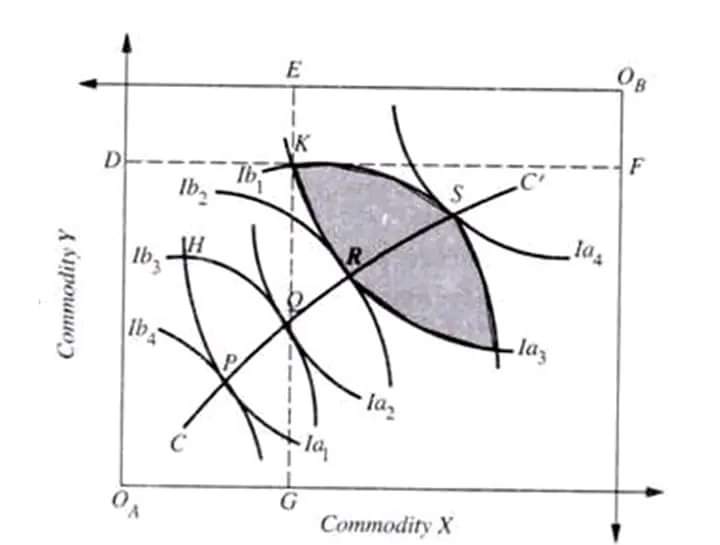Pareto Criterion of Social Welfare
According to Prof. Baumol “any change which harms no one and which makes some people better off, this state of change must be considered to be an improvement.”
Suppose there are two persons A and B in a society and consume two goods X and Y. The various levels of their satisfaction by consuming various combinations of the two goods have been represented by their respective indifference curves.

In Figure, Oa and Ob are the origins for the utilities of two persons A and B respectively. Ia1, Ia2, Ia3, Ia4 and Ib1, Ib2, Ib3, Ib4 are their successively higher indifference curve. Suppose the initial distribution of goods X and Y between A and B is represented by point- K in the Edgeworth Box. Here K can be assumed as equilibrium point for both the persons in the initial stage.
Accordingly, individual A consumes OAG quantity of X + GK quantity of Y and is at the level of satisfaction represented by indifference curve Ia3. Similarly, individual B consumes KF quantity of X+ KE quantity of Y and gets the satisfaction represented by indifference curve Ib1. Thus the total given quantity of goods X and Y is distributed between A and B. In this distribution, individual A consumes relatively large quantity of good Y and individual B consumes more of good X. Now, it can be shown with the aid of Pareto’s welfare criterion that a movement from the point K to a point such as S or R or any other point in the shaded region will increase social welfare.
As shown in the diagram any change in the distribution pattern of two goods will definitely increase the satisfaction level of at least one person. If we move from K to S through redistribution of two goods between two individuals, it increases the level of satisfaction of A without any change in the satisfaction of B. Here A has been able to increase his satisfaction by moving to a higher indifference curve Ia4, whereas B remains on the same indifference curve Ib1 because K and S lie on same indifference curve Ib1 associated to B.
Thus, as a result of the movement from K to S, individual A has become better off whereas individual B is no worse off. Similarly, the movement from K to R is also desirable from the point of view of social welfare because in this individual B becomes better off without any change-in-the satisfaction of individual A. Therefore, both the positions S and R are better than K.
The tangency points of the various indifference curves of the two individuals of the society are the Pareto optimum points and the locus of these points is called ‘contra
